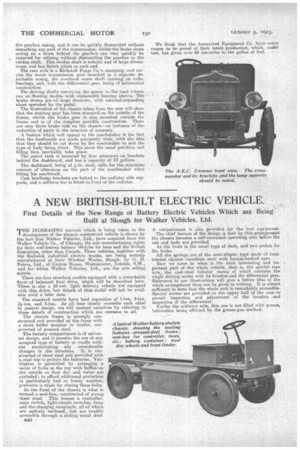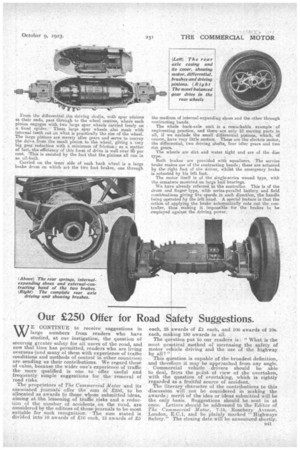• A NEW BRITISH-BUILT ELECTRIC VEHICLE.
Page 22

Page 23

If you've noticed an error in this article please click here to report it so we can fix it.
First Details of the New Range of Battery Electric Vehicles Which are Being Built at Slough for Walker Vehicles, Ltd.
THE INCREASING interest which is being taken in the
development of the electric commercial vehicle is shown by the fact that Walker Vehicles, Ltd., have acquired from the Walker. Vehicle Co., of ,Chicago the sole manufacturing rights for their well-known battery Vihieles for here and the British Dominions, other than Canada. These vehicles, together with the Railodok industrial electric -trucks, are being entirely manufactured at their Windsor Works, Slough, by G. D. Peters, Ltd., of Caxton House, Westminster, London, S.W., and for 'whom Walker Vehicles, Ltd., are the sole selling agents., .
There are four standard models equipped with a remarkable form' of balanced final drive, which will be described later. There is 'also a 10-cwt. light delivery vehicle not equipped with thisdriive but details of this model will not be available until a later date.
The standard models have load capacities of 1-ton, 2-ton, 3i-ton, and 5-ton. As all four closely resemble each other in general design, we will content ourselves by referring to those details of construction which are common to all.
The chassis frame is strongly constructed and provided at the front with stout buffer member or fender, constructed of pressed steel. The battery compartment is of universal design, and it permits the use of any accepted type of battery or cradle without necessitating any considerable changes in the stracture. It is constructed of sheet steel and provided with a steel top to protect the batteries. Ventilation 3s permitted by arranging a series of holes at, the top with baffles on the outside so that dirt and water are excluded; to afford additional protection in particularly bad . or frosty weather, provision is made for closing these holes.
At the front of the chassis is what is termed a seat-box, constructed of strong sheet steel. This houses a controller, main switch, light-circuit switches, fuses and the charging receptacle, all of which are entirely enclosed, .but are readily accessible through a sliding metal door. A. compartment is also provided for the tool equipment. The chief feature of the design is that by this, arrangement the chassis becomes a self-contained operating unit before the cab and body are provided. At the front is the usual type of dash, and two pedals for the brake.
All the springs are of the semi-elliptic type made of beattreated chrome vanadium steel with bronze-bushed eyes.
Now we come to what is the most interesting and important part of the whole vehicle, that is, the special rear axle,, the cast-steel tubular casing of which contains the single driving motor with its brushes and the differential gear. Reference to our illustrations will give a better idea of the whole arrangement than can be given in writing. It is almost sufficient to state that the whole unit is remarkably accessible. Special covers are provided in the upper half of the case to permit inspection and adjustment of the brushes and inspection of the differential. Unlike the ordinary axle, this one is not filled with grease, lubrication being effected by the grease-gun method..
From the differential the driving shafts, with spur pinions at their ends, pass through to the wheel centres, where each pinion engages with two large spur ,wheels 'carried freely on a fixed. spider. These large , spur wheels also mesh with internal teeth cut On What is practically the rim of the wheel. The large Pinions are merely idler gears and serve to convey the drive from the small pinion to tha wheel; giVing a very big gear reduction with a minimum of friction; as a matter of fact,•the efficiency of this form of drive is well over 'a:5 Per cent. "..This is assisted by the fact thatthe pinions all fain in an oil-bath.
Carried • on the inner side of each back wheel is a large brake drum on which act the two foot brakes, one through
the medium, of internal-expanding shoes and the other through contracting bands. The whole back-axle unit is a retharkable example • of engineering practice, and there are only 10 moving parts in all, if we exclude the small differential pinions, which, of course,, have very little motion. These are the electric motor, the differential, two driving shafts, four idler gears and two rim gears.
The wheels are dirt and water tight and are of the disc type.
Both brakes are provided with equalizers. The service brake makes use of the contracting bands; these are actuated by the right foot of the driver, whilst the emergency brake is actuated by his left foot. The motor itself is of the Single-series wound type, with the armature mounted on large ball bearings.
We have already referred to the controller. This is of the drum and finger type, with series-parallel battery and field combinations giving five speeds in each direction, the handle being operated by the left hand. A special feature is that the action of applying the brake automatically cuts out the controller, thus making it impossible for the brakes to be employed against the driving power.
































